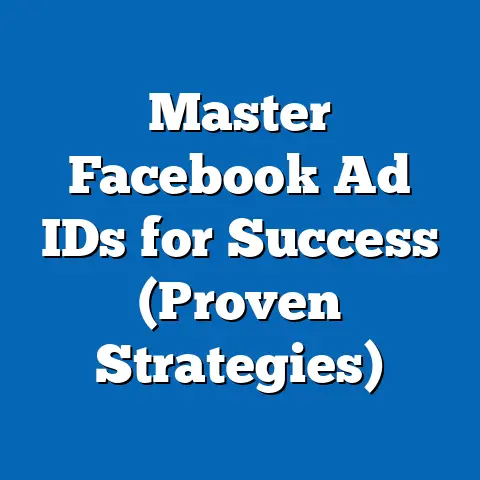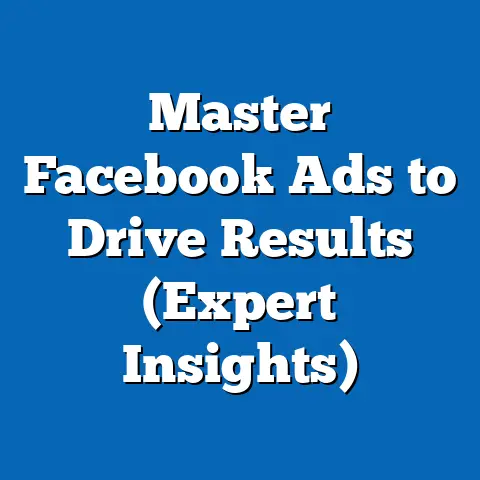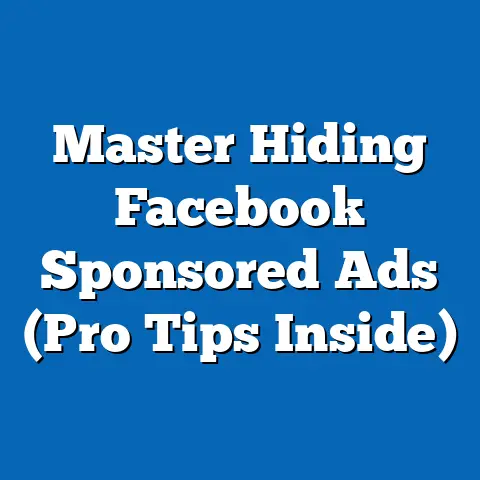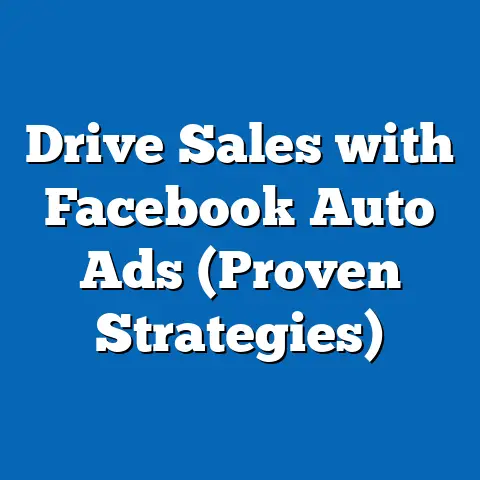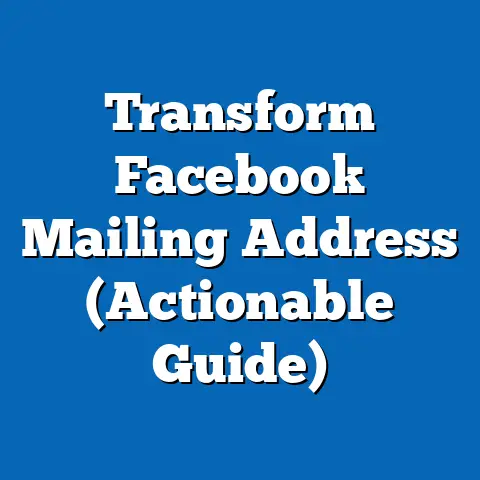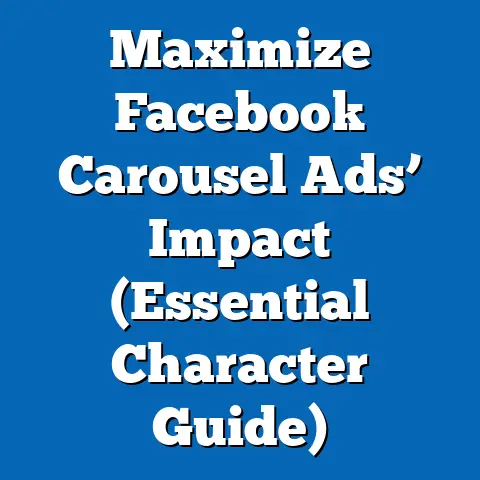Create a Winning Facebook Ad in Minutes (Proven Strategy)
Why did the marketer break up with the calendar? Because it had too many dates! Okay, now that I’ve (hopefully) gotten your attention with a bit of marketing humor, let’s dive into something far more serious: creating Facebook ads that actually deliver results. In today’s fast-paced digital world, grabbing attention is harder than ever. We’re bombarded with information, and our attention spans are shrinking faster than my patience on a Monday morning. That’s why crafting effective Facebook ads quickly is crucial. This isn’t just about throwing money at a problem; it’s about strategic efficiency and maximizing your ROI.
This guide is designed to equip you with the knowledge and tools to create compelling Facebook ads in minutes, not hours. I’ll walk you through understanding the platform, crafting your message, leveraging proven strategies, and optimizing for success. Let’s get started!
Understanding Facebook Ads
What Are Facebook Ads?
Facebook ads are paid messages that businesses use to reach specific audiences on the Facebook platform (including Instagram, Messenger, and the Audience Network). Unlike organic posts, which are only seen by your followers and their friends, Facebook ads can be targeted to users based on demographics, interests, behaviors, and more. This precision targeting is what makes Facebook advertising so powerful.
Think of it this way: if you’re selling organic dog treats, you can target Facebook ads to dog owners in your local area who are interested in organic products. That’s a far cry from hoping your organic dog treat post randomly shows up on the newsfeed of someone who fits that description.
According to Statista, Facebook’s advertising revenue reached nearly $117 billion in 2023. That’s not just a big number; it’s a testament to the effectiveness and widespread adoption of Facebook ads by businesses worldwide. Facebook’s massive reach, combined with its sophisticated targeting capabilities, makes it a goldmine for marketers.
Why Facebook Ads Matter
For businesses of all sizes, Facebook advertising offers a unique opportunity to connect with potential customers in a meaningful way. Here’s why it matters:
- Targeted Reach: As I mentioned earlier, Facebook’s targeting options are incredibly granular. You can target users based on age, location, interests, behaviors, education, job title, and even life events (like getting married or having a baby). This allows you to reach the people who are most likely to be interested in your products or services.
- Measurable Results: Unlike traditional advertising methods (like print or TV), Facebook ads provide detailed performance metrics. You can track impressions, clicks, conversions, cost per acquisition, and more. This data allows you to optimize your campaigns and maximize your ROI.
- Brand Awareness: Even if your primary goal isn’t direct sales, Facebook ads can be a powerful tool for building brand awareness. By consistently showing your brand to your target audience, you can increase familiarity and recognition.
- Flexibility and Scalability: Facebook ads are incredibly flexible. You can start with a small budget and gradually increase it as you see results. You can also test different ad creatives, targeting options, and bidding strategies to find what works best for your business.
- Affordability: Compared to other advertising channels, Facebook ads can be relatively affordable. You can set your own budget and control how much you spend. This makes it accessible to small businesses and startups with limited marketing budgets.
Takeaway: Facebook ads are a powerful tool for businesses of all sizes, offering targeted reach, measurable results, brand awareness, flexibility, and affordability.
The Anatomy of a Winning Facebook Ad
Key Components of an Ad
A winning Facebook ad isn’t just about pretty pictures; it’s about a carefully constructed message that resonates with your target audience. Here are the key components:
- Headline: The headline is the first thing people see, so it needs to be attention-grabbing and relevant. Think of it as your elevator pitch. Keep it short, sweet, and to the point.
- Image/Video: Visuals are crucial for capturing attention on a crowded newsfeed. Use high-quality images or videos that are relevant to your product or service.
- Ad Copy: The ad copy provides more details about your offer and why people should care. Use persuasive language, highlight benefits, and create a sense of urgency.
- Call-to-Action (CTA): The CTA tells people what you want them to do next. Use clear and concise language, such as “Shop Now,” “Learn More,” “Sign Up,” or “Get a Quote.”
Each of these components plays a critical role in the overall effectiveness of your ad. A weak headline can cause people to scroll past your ad without even noticing it. A blurry image can make your brand look unprofessional. Vague ad copy can leave people confused and uninterested. And a weak CTA can prevent people from taking the desired action.
Choosing the Right Format
Facebook offers a variety of ad formats to choose from, each with its own strengths and weaknesses:
- Single Image Ads: These are the simplest and most common ad format. They consist of a single image, headline, ad copy, and CTA. They’re great for showcasing a product or service in a visually appealing way.
- Single Video Ads: Video ads are more engaging than image ads and can be used to tell a story or demonstrate a product in action. They’re great for building brand awareness and driving conversions.
- Carousel Ads: Carousel ads allow you to showcase multiple images or videos in a single ad. This format is great for showcasing a range of products or highlighting different features of a single product.
- Collection Ads: Collection ads are designed for e-commerce businesses. They allow you to showcase a collection of products in a visually appealing way, making it easy for people to browse and purchase your products.
- Slideshow Ads: Slideshow ads are similar to video ads, but they’re created using a series of still images. This format is great for businesses with limited video production resources.
- Instant Experience Ads: Instant Experience ads are full-screen ads that open when someone clicks on your ad. This format allows you to create a more immersive and engaging experience for your audience.
The best ad format for your business will depend on your specific goals and target audience. For example, if you’re selling clothing, carousel ads might be a good choice because they allow you to showcase multiple outfits. If you’re selling software, a video ad might be a better choice because it allows you to demonstrate the software in action.
Takeaway: Understanding the key components of a Facebook ad and choosing the right format are essential for creating effective campaigns.
Crafting Your Ad Message
Know Your Audience
Before you start writing ad copy or selecting visuals, you need to understand your target audience. Who are you trying to reach? What are their interests, needs, and pain points? What motivates them to buy?
There are several ways to research your target audience:
- Facebook Audience Insights: This free tool provides detailed information about the demographics, interests, and behaviors of people on Facebook.
- Customer Surveys: Ask your existing customers about their experiences with your products or services. What do they like? What could be improved?
- Social Listening: Monitor social media conversations to see what people are saying about your brand, your competitors, and your industry.
- Website Analytics: Analyze your website traffic to see who is visiting your site and what they’re doing.
Once you have a good understanding of your target audience, you can start crafting your ad message.
Writing Compelling Copy
Your ad copy should be clear, concise, and persuasive. It should highlight the benefits of your product or service and create a sense of urgency. Here are some tips for writing compelling ad copy:
- Use strong headlines: Your headline should grab attention and make people want to learn more.
- Focus on benefits, not features: People don’t care about the technical specifications of your product; they care about how it will make their lives better.
- Use persuasive language: Use words that evoke emotion and create a sense of urgency, such as “limited time offer,” “exclusive deal,” or “don’t miss out.”
- Include a clear call-to-action: Tell people what you want them to do next, such as “Shop Now,” “Learn More,” or “Sign Up.”
- Keep it short and sweet: People have short attention spans, so get to the point quickly.
Storytelling can be a powerful tool for making your ad copy more relatable. Share a story about how your product or service has helped someone else. This can help people connect with your brand on an emotional level.
Selecting Eye-Catching Visuals
Visuals are crucial for capturing attention on a crowded newsfeed. Use high-quality images or videos that are relevant to your product or service. Here are some tips for selecting eye-catching visuals:
- Use high-quality images and videos: Blurry or pixelated visuals will make your brand look unprofessional.
- Choose visuals that are relevant to your product or service: Don’t use generic stock photos.
- Use visuals that are visually appealing: Choose images and videos that are colorful, well-lit, and visually interesting.
- Use visuals that evoke emotion: Choose visuals that make people feel something, such as happiness, excitement, or nostalgia.
- Test different visuals: Experiment with different images and videos to see what works best for your audience.
Takeaway: Crafting a compelling ad message requires understanding your audience, writing persuasive copy, and selecting eye-catching visuals.
Proven Strategies for Quick Ad Creation
Template Approach
One of the fastest ways to create Facebook ads is to use templates. Templates provide a pre-designed framework for your ads, saving you time and effort. There are many free and paid templates available online.
Here’s a step-by-step guide on how to use templates to create ads quickly:
- Find a template: Search online for Facebook ad templates that are relevant to your industry and goals.
- Customize the template: Replace the placeholder text and images with your own content.
- Add your branding: Add your logo, colors, and fonts to the template to make it consistent with your brand.
- Write your ad copy: Use the tips in the previous section to write compelling ad copy that resonates with your audience.
- Add a call-to-action: Tell people what you want them to do next.
- Preview your ad: Make sure your ad looks good on both desktop and mobile devices.
- Publish your ad: Once you’re happy with your ad, publish it to Facebook.
Using templates can significantly speed up the ad creation process without sacrificing quality.
Using Facebook’s Ad Tools
Facebook offers a variety of tools to help you create and manage your ads. Here are some of the most useful tools:
- Ad Manager: The Ad Manager is your central hub for creating, managing, and tracking your Facebook ads. It allows you to create ad campaigns, set your budget, target your audience, and track your performance.
- Creative Hub: The Creative Hub is a tool that allows you to create mockups of your ads and preview them on different devices. This is a great way to see how your ads will look before you publish them.
- Facebook Pixel: The Facebook Pixel is a piece of code that you can install on your website to track conversions from your Facebook ads. This data allows you to optimize your campaigns and maximize your ROI.
- A/B Testing: Facebook allows you to A/B test different versions of your ads to see which ones perform best. This is a great way to experiment with different headlines, images, ad copy, and CTAs.
Leveraging these tools can streamline the ad creation process and help you create more effective campaigns.
Setting Up Your Campaign
Setting up your Facebook ad campaign involves several steps:
- Choose your objective: What do you want to achieve with your campaign? Do you want to drive traffic to your website, generate leads, or increase sales?
- Set your budget: How much are you willing to spend on your campaign? You can set a daily budget or a lifetime budget.
- Target your audience: Who are you trying to reach with your campaign? Use Facebook’s targeting options to reach people based on demographics, interests, behaviors, and more.
- Choose your ad placements: Where do you want your ads to appear? You can choose to show your ads on Facebook, Instagram, Messenger, and the Audience Network.
- Create your ads: Use the tips in the previous sections to create compelling ads that resonate with your audience.
- Track your performance: Monitor your campaign performance using Facebook Insights.
Takeaway: Using templates, leveraging Facebook’s ad tools, and following a structured campaign setup process can help you create effective Facebook ads quickly.
Optimizing Your Ad for Success
Tracking Performance
Once your ads are running, it’s important to track their performance. Facebook Insights provides detailed data on your ad performance, including impressions, clicks, conversions, cost per acquisition, and more.
Here are some key performance indicators (KPIs) that marketers should focus on:
- Click-Through Rate (CTR): The CTR measures the percentage of people who click on your ad after seeing it. A high CTR indicates that your ad is relevant and engaging.
- Cost Per Click (CPC): The CPC measures how much you’re paying for each click on your ad. A low CPC indicates that your ad is efficient.
- Conversion Rate: The conversion rate measures the percentage of people who take the desired action after clicking on your ad (e.g., making a purchase, signing up for a newsletter). A high conversion rate indicates that your ad is effective.
- Cost Per Acquisition (CPA): The CPA measures how much you’re paying for each conversion. A low CPA indicates that your ad is cost-effective.
- Return on Ad Spend (ROAS): The ROAS measures how much revenue you’re generating for every dollar you spend on advertising. A high ROAS indicates that your ad is profitable.
Making Data-Driven Adjustments
Based on your performance data, you can make adjustments to your ads to improve their effectiveness. Here are some strategies for tweaking your ads:
- Test different headlines: Experiment with different headlines to see which ones generate the most clicks.
- Test different images and videos: Experiment with different visuals to see which ones capture the most attention.
- Test different ad copy: Experiment with different ad copy to see which one resonates most with your audience.
- Test different CTAs: Experiment with different CTAs to see which ones drive the most conversions.
- Refine your targeting: If your ads aren’t performing well, try refining your targeting options to reach a more relevant audience.
- Adjust your budget: If your ads are performing well, consider increasing your budget to reach more people.
Ongoing testing and iteration are essential for improving the effectiveness of your Facebook ads. Don’t be afraid to experiment with different approaches to see what works best for your business.
Takeaway: Tracking performance and making data-driven adjustments are crucial for optimizing your Facebook ads for success.
Conclusion
Creating winning Facebook ads doesn’t have to be a daunting task. By understanding the platform, crafting your message, leveraging proven strategies, and optimizing for success, you can create effective ads in minutes, not hours.
Remember to:
- Understand your audience: Know who you’re trying to reach and what motivates them.
- Craft compelling copy: Use persuasive language, highlight benefits, and create a sense of urgency.
- Select eye-catching visuals: Use high-quality images and videos that are relevant to your product or service.
- Use templates and Facebook’s ad tools: These resources can streamline the ad creation process.
- Track your performance: Monitor your campaign performance and make data-driven adjustments.
I encourage you to take the knowledge you’ve gained from this guide and put it into practice immediately. Create your first Facebook ad and see the results for yourself!
Call to Action
Now it’s your turn! Share your own experiences or success stories with Facebook ads in the comments below. What strategies have worked best for you? What challenges have you faced? I’m eager to hear from you. If you have any questions or need more information, don’t hesitate to reach out. Happy advertising!

